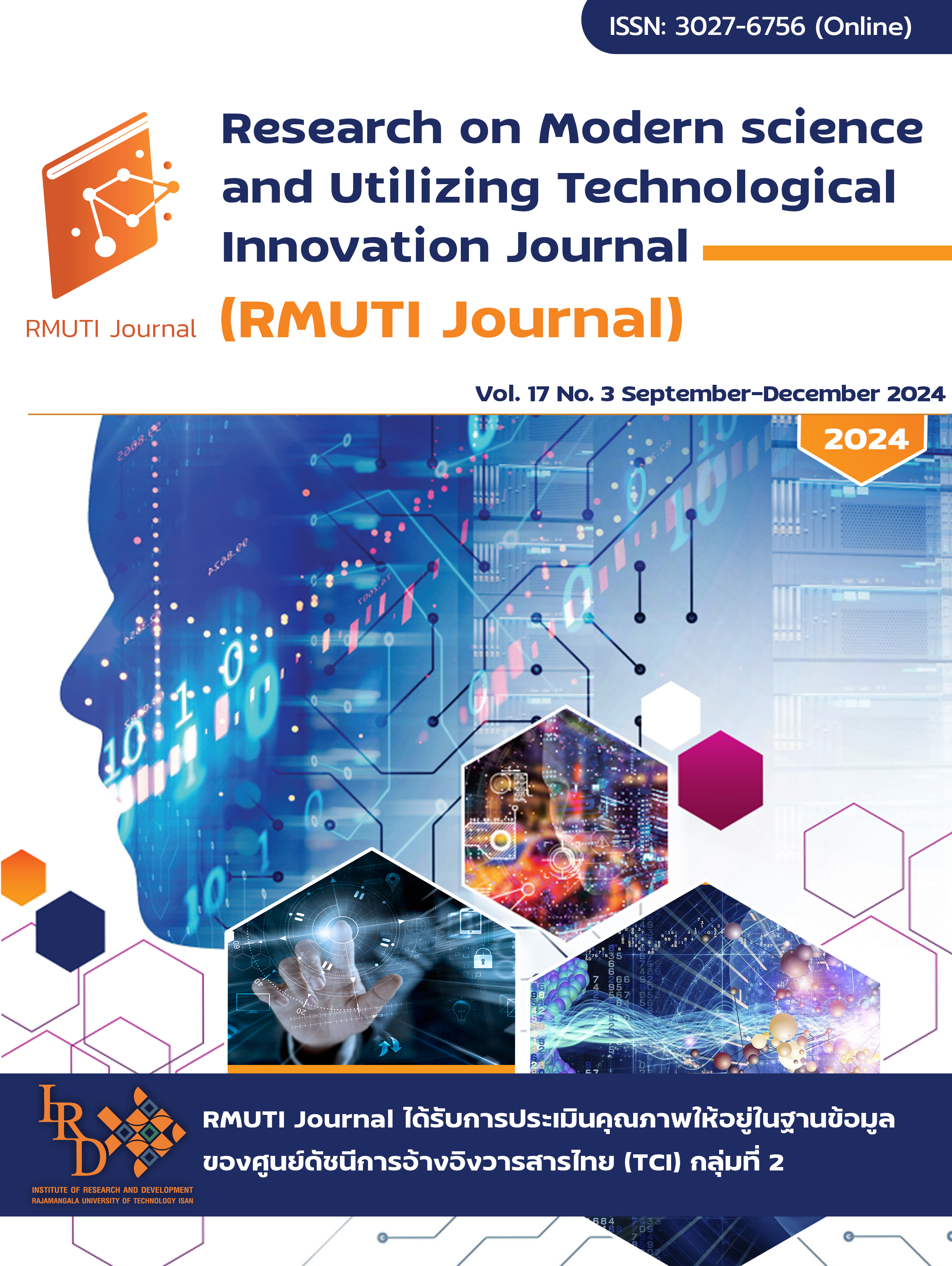การศึกษาผลกระทบของโมเดลการจัดสรรเวลา 8+8+8 ต่อประสิทธิภาพการทำงานและคุณภาพชีวิต: กรณีศึกษาเปรียบเทียบระหว่างประเทศ
Main Article Content
บทคัดย่อ
การศึกษานี้มุ่งวิเคราะห์ผลกระทบของโมเดลการจัดสรรเวลา 8+8+8 (8 ชั่วโมงสำหรับการทำงาน การนอน และการใช้ชีวิต) ต่อประสิทธิภาพการทำงานและคุณภาพชีวิต โดยทำการเปรียบเทียบระหว่างประเทศ งานวิจัยนี้ใช้วิธีการวิเคราะห์เชิงปริมาณและคุณภาพ ผ่านการสร้างแบบจำลองทางคณิตศาสตร์และมีการพิสูจน์ด้วยกระบวนการทางคณิตศาสตร์ ผลการศึกษาพบว่า การจัดสรรเวลาตามโมเดล 8+8+8 มีความสัมพันธ์เชิงบวกกับประสิทธิภาพการทำงานและคุณภาพชีวิตในหลายประเทศ อย่างไรก็ตาม ความแตกต่างทางวัฒนธรรมและเศรษฐกิจมีผลต่อการนำโมเดลไปปรับใช้ การศึกษานี้นำเสนอข้อเสนอแนะสำหรับการปรับใช้โมเดลให้เหมาะสมกับบริบทของแต่ละประเทศ เพื่อเพิ่มประสิทธิภาพการทำงานและยกระดับคุณภาพชีวิตของประชากร
Article Details

อนุญาตภายใต้เงื่อนไข Creative Commons Attribution-NonCommercial-NoDerivatives 4.0 International License.
เอกสารอ้างอิง
Owen, R. (1817). A New View of Society. In The Life of Robert Owen. Effingham Wilson
BBC News. (2012). Call-centre Workers in Wrexham Try Out Six-Hour Day. Access (11 May 2012). Available (https://www.bbc.com/news/uk-wales-mid-wales-18041257)
Mimi's Plan. (2023). Good Things are Coming [Facebook]. Access (27 July 2024). Available (https://www.facebook.com/photo/?fbid=772497441748385&set=a.470410441957088)
Bloomberg News. (2016). The Six-Hour Workday Works in Sweden. But what about in workaholic North America?. Access (11 May 2012). Available (https://financialpost.com/executive/careers/the-six-hour-workday-works-in-sweden-but-what-about-in-workaholic-north-america)
Fagnani, J. and Letablier, M. -T. (2004). Work and Family Life Balance: The Impact of the 35-Hour Laws in France. Work, Employment and Society. Vol. 18, Issue 3, pp. 551-572. DOI: 10.1177/0950017004045550
Bosch, G. and Lehndorff, S. (2001). Working-Time Reduction and Employment: Experiences in Europe and Economic Policy Recommendations. Cambridge Journal of Economics. Vol. 25, Issue 2, pp. 209-243. DOI: 10.1093/cje/25.2.209
Lin, R., Lin, Y., Hsia, Y., and Kuo, C. (2021). Long Working Hours and Burnout in Health Care Workers: Non‐Linear Dose‐Response Relationship and the Effect Mediated by Sleeping Hours—A Cross‐Sectional Study. Journal of Occupational Health. Vol. 63, Issue 1, e12228. DOI: 10.1002/1348-9585.12228
Campbell, T. T. (2024). The Four-Day Work Week: a Chronological, Systematic Review of the Academic Literature. Management Review Quarterly. Vol. 74, pp. 1791-1807. DOI: 10.1007/s11301-023-00347-3
Visser, J. (2002). The First Part-Time Economy in the World: A Model to be Followed?. Journal of European Social Policy. Vol. 12, Issue 1, pp. 23-42. DOI: 10.1177/0952872002012001561
Vainio, H. (2000). Modification of Lung Cancer Prevention by Gene-Nutrient Interaction. Scandinavian Journal of Work, Environment & Health. Vol. 26, Issue 6, pp. 459-460. DOI: 10.5271/sjweh.568
Greenhaus, J. H. and Allen, T. D. (2011). Work-Family Balance: A Review and Extension of the Literature. In Quick, J. C. and Tetrick, L. E. (Eds.), Handbook of Occupational Health Psychology, American Psychological Association. pp. 165-183
Cirillo, F. (2018). The Pomodoro Technique: The Acclaimed Time-Management System That Has Transformed How We Work. United States by Currency, Penguin Random House LLC, New York
Gill, P. (2011). The Pomodoro Technique: Is It Right for You?. Access (11 May 2012). Available (https://www.pomodorotechnique.com/)
Impact Lab LLC. (2020). Why taking breaks can make you happier, more focused, and more productive. Access (11 May 2012). Available (https://www.impactlab.com/2014/09/08/why-taking-breaks-can-make-you-happier-more-focused-and-more-productive/)
BBC. (2021). Four-day week 'an overwhelming success' in Iceland. Access (11 May 2012). Available (https://www.bbc.com/news/business-57724779)
Perlow, L. A. and Porter, J. L. (2009). Making Time Off Predictable__and Required. Magazine Article. Harvard Business Review
Hill, E. J., Hawkins, A. J., Ferris, M., and Weitzman, M. (2001). Finding an Extra Day a Week: The Positive Influence of Perceived Job Flexibility on Work and Family Life Balance. Family Relations. Vol. 50, Issue 1, pp. 49-58. DOI: 10.1111/j.1741-3729.2001.00049.x
Drucker, P. (1999). Management Challenges for the 21st Century. New York: Harper Collins
Felstead, A. and Henseke, G. (2017). Assessing the Growth of Remote Working and Its Consequences for Effort, Well-Being and Work-Life Balance. New Technology, Work and Employment. Vol. 32, Issue 3, pp. 195-212. DOI: 10.1111/ntwe.12097
Bryson, A. and MacKerron, G. (2016). Are you happy while you work?. The Economic Journal. Vol. 127, Issue 599, pp. 106-125. DOI: 10.1111/ecoj.12269
Haar, J. M., Russo, M., Suñe, A., and Ollier-Malaterre, A. (2014). Outcomes of Work-Life Balance on Job Satisfaction, Life Satisfaction and Mental Health: A Study Across Seven Cultures. Journal of Vocational Behavior. Vol. 85, Issue 3, pp. 361-373. DOI: 10.1016/j.jvb.2014.08.010
Perpetual Guardian. (2019). White Paper - The Four-Day Week. Access (11 May 2012). Available (https://www.4dayweek.com/)
Perpetual Guardian. (2024). The Four-Day Week is Here. Access (11 May 2012). Available (https://www.perpetualguardian.co.nz/the-four-day-week-is-here/)
Baltes, B. B., Briggs, T. E., Huff, J. W., Wright, J. A., and Neuman, G. A. (1999). Flexible and Compressed Workweek Schedules: A Meta-Analysis of Their Effects on Work-Related Criteria. Journal of Applied Psychology. Vol. 84, Issue 4, pp. 496-513. DOI: 10.1037/0021-9010.84.4.496
Bloom, N., Liang, J., Roberts, J., and Ying, Z. J. (2015). Does working from home work? Evidence from a Chinese experiment. The Quarterly Journal of Economics. Vol. 130, Issue 1, pp. 165-218. DOI: 10.1093/qje/qju032
Open AI. (2024). Model Effects 8+8+8. Access (16 October 2024). Available (https://chatgpt.com/share/670f52e3-d530-800d-ae09-c022e9f2b863)
Anthropic. (2024). AI Research and Products that Put Safety at the Frontier. Access (11 May 2012). Available (https://www.anthropic.com/)
Ministry of Labour. (2019). Report on the Survey of Working Conditions of the Population 2019. Access (11 May 2012). Available (https://www.mol.go.th/)
Athirah Saidi, N. S., Michael, F. L., Sumilan, H., Omar Lim, S. L., Jonathan, V., Hamidi, H., and Abg Ahmad, A. I. (2018). The Relationship Between Working Environment and Employee Performance. Journal of Cognitive Sciences and Human Development. Vol. 5, No. 2, pp. 14-22. DOI: 10.33736/jcshd.1916.2019
Grimmett, G. and Stirzaker, D. (2020). Probability and Random Processes (4th ed.). Oxford University Press


